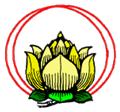
Information on the Mindfulness
Practice Group for New Sangha-friends

|
Before meetings:
We view our meeting room as a Meditation Hall and therefore prepare to enter the place of practice by removing our shoes
and speaking very quietly, if it is necessary to speak, outside the Hall. We create the special space in which our sangha
exists by marking the boundaries of the place with our respect and the boundaries in time with the bell.
During meetings: Each sound of the bell invites us to rest in the sangha. We stop whatever we are doing. At perfect rest, we take three mindful breaths, for about half a minute, before we resume our activity or discussion in renewed mindfulness. We may invite the bell, if discussion or activity has become too automatic or frenetically paced. When we place our hands together and bow, we are making an offering of our presence to the whole sangha, embodying our respect and affection. Our hands form a lotus bud, a flower offered the group. We look about before we “bow in” to discussion to see if someone else wishes to “bow in.” We bow out at the end of our comments, so that our friends may contemplate what we have said in its fullness. We try to leave three breaths between comments for contemplation. You may see an offering bowl near the front of the meeting. Offerings are directed to three basic ends. The MPG regularly makes donations to UUCA for the use of the space and utilities. The MPG also maintains a scholarship fund to send sangha-friends to retreats and events they could not otherwise attend. It sometimes receives special appeals from other dharma-sharing groups and may respond to these. Donations are made in accordance with votes of the sangha.
Sangha: In our meditative tradition, a sangha is any group of practitioners who gather to practice the Buddhadharma, big or small, with a famous teacher or with no teacher. Buddhadharma: Dharma is how things exist and work. Buddhadharma is explanation of the dharma by Buddhist teachers. Mahayana: northern Buddhism, stretching from Tibet through China to Korea and Japan, featuring belief in the universality of Buddhanature and therefore Buddhahood as well as an emphas is on the values of compassion and wisdom, enacted in bodhicitta (the desire to benefit all sentient beings), and leading to the comprehension of emptiness. Buddha: Literally any enlightened person. “The” Buddha: Gautama, Shakya clan, d. c. 480 BC. Zen: that branch of the Mahayana which especially attempts to defeat conceptualization via absorption in experience leading to comprehension of nonduality. Sutras are not as valuable as comprehension via experience. Sutra/sutta: Suttas are the texts in the Pali [language] “canon,” treated as authoritative by Theravada (Southeast Asian) Buddhism. The Sanskrit term sutra includes those texts as well as later, influential texts in the Buddhadharma such as the Heart Sutra. Texts are valued for their presentation of dharma and not because they are thought to be the actual words of “the” Buddha.
Basic Introduction to Mindfulness and Meditation: Bhante Gunaratana, Mindfulness in Plain English
Source of ceremonies used in this sangha: Thich Nhat Hanh, Chanting from the Heart Source of organizational principles for the sangha and of speech and conduct guidelines in the practice book: Thich Nhat Hanh, et al. Friends Along the Path and Thich Nhat Hanh, Joyfully Together: The Art of Building a Harmonious Community
Click here to download this information as a PDF
(last updated 1/24/2010)
|
 The Mindfulness Practice Group
is a spirituality program of the Unitarian
The Mindfulness Practice Group
is a spirituality program of the Unitarian